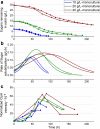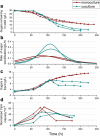Coculture with hemicellulose-fermenting microbes reverses inhibition of corn fiber solubilization by Clostridium thermocellum at elevated solids loadings
- PMID: 33461608
- PMCID: PMC7814735
- DOI: 10.1186/s13068-020-01867-w
Coculture with hemicellulose-fermenting microbes reverses inhibition of corn fiber solubilization by Clostridium thermocellum at elevated solids loadings
Abstract
Background: The cellulolytic thermophile Clostridium thermocellum is an important biocatalyst due to its ability to solubilize lignocellulosic feedstocks without the need for pretreatment or exogenous enzyme addition. At low concentrations of substrate, C. thermocellum can solubilize corn fiber > 95% in 5 days, but solubilization declines markedly at substrate concentrations higher than 20 g/L. This differs for model cellulose like Avicel, on which the maximum solubilization rate increases in proportion to substrate concentration. The goal of this study was to examine fermentation at increasing corn fiber concentrations and investigate possible reasons for declining performance.
Results: The rate of growth of C. thermocellum on corn fiber, inferred from CipA scaffoldin levels measured by LC-MS/MS, showed very little increase with increasing solids loading. To test for inhibition, we evaluated the effects of spent broth on growth and cellulase activity. The liquids remaining after corn fiber fermentation were found to be strongly inhibitory to growth on cellobiose, a substrate that does not require cellulose hydrolysis. Additionally, the hydrolytic activity of C. thermocellum cellulase was also reduced to less-than half by adding spent broth. Noting that > 15 g/L hemicellulose oligosaccharides accumulated in the spent broth of a 40 g/L corn fiber fermentation, we tested the effect of various model carbohydrates on growth on cellobiose and Avicel. Some compounds like xylooligosaccharides caused a decline in cellulolytic activity and a reduction in the maximum solubilization rate on Avicel. However, there were no relevant model compounds that could replicate the strong inhibition by spent broth on C. thermocellum growth on cellobiose. Cocultures of C. thermocellum with hemicellulose-consuming partners-Herbinix spp. strain LL1355 and Thermoanaerobacterium thermosaccharolyticum-exhibited lower levels of unfermented hemicellulose hydrolysis products, a doubling of the maximum solubilization rate, and final solubilization increased from 67 to 93%.
Conclusions: This study documents inhibition of C. thermocellum with increasing corn fiber concentration and demonstrates inhibition of cellulase activity by xylooligosaccharides, but further work is needed to understand why growth on cellobiose was inhibited by corn fiber fermentation broth. Our results support the importance of hemicellulose-utilizing coculture partners to augment C. thermocellum in the fermentation of lignocellulosic feedstocks at high solids loading.
Conflict of interest statement
CDH is supported by Enchi Corporation, and LRL is supported by and has a financial interest in Enchi, which is a for-profit company that seeks to commercialize C-CBP technology.
Figures







Similar articles
-
Declining carbohydrate solubilization with increasing solids loading during fermentation of cellulosic feedstocks by Clostridium thermocellum: documentation and diagnostic tests.Biotechnol Biofuels Bioprod. 2022 Feb 5;15(1):12. doi: 10.1186/s13068-022-02110-4. Biotechnol Biofuels Bioprod. 2022. PMID: 35418299 Free PMC article.
-
Solubilization of sugarcane bagasse by mono and cocultures of thermophilic anaerobes with and without cotreatment.Bioresour Technol. 2024 Aug;406:130982. doi: 10.1016/j.biortech.2024.130982. Epub 2024 Jun 13. Bioresour Technol. 2024. PMID: 38879055
-
The effect of switchgrass loadings on feedstock solubilization and biofuel production by Clostridium thermocellum.Biotechnol Biofuels. 2017 Nov 30;10:233. doi: 10.1186/s13068-017-0917-7. eCollection 2017. Biotechnol Biofuels. 2017. PMID: 29213307 Free PMC article.
-
Conversion for Avicel and AFEX pretreated corn stover by Clostridium thermocellum and simultaneous saccharification and fermentation: insights into microbial conversion of pretreated cellulosic biomass.Bioresour Technol. 2011 Sep;102(17):8040-5. doi: 10.1016/j.biortech.2011.05.021. Epub 2011 May 14. Bioresour Technol. 2011. PMID: 21683579
-
Development of a thermophilic coculture for corn fiber conversion to ethanol.Nat Commun. 2020 Apr 22;11(1):1937. doi: 10.1038/s41467-020-15704-z. Nat Commun. 2020. PMID: 32321909 Free PMC article.
Cited by
-
Biological cellulose saccharification using a coculture of Clostridium thermocellum and Thermobrachium celere strain A9.Appl Microbiol Biotechnol. 2022 Mar;106(5-6):2133-2145. doi: 10.1007/s00253-022-11818-0. Epub 2022 Feb 14. Appl Microbiol Biotechnol. 2022. PMID: 35157106 Free PMC article.
-
Growth-uncoupled propanediol production in a Thermoanaerobacterium thermosaccharolyticum strain engineered for high ethanol yield.Sci Rep. 2023 Feb 10;13(1):2394. doi: 10.1038/s41598-023-29220-9. Sci Rep. 2023. PMID: 36765076 Free PMC article.
-
Declining carbohydrate solubilization with increasing solids loading during fermentation of cellulosic feedstocks by Clostridium thermocellum: documentation and diagnostic tests.Biotechnol Biofuels Bioprod. 2022 Feb 5;15(1):12. doi: 10.1186/s13068-022-02110-4. Biotechnol Biofuels Bioprod. 2022. PMID: 35418299 Free PMC article.
-
Integrated engineering of enzymes and microorganisms for improving the efficiency of industrial lignocellulose deconstruction.Eng Microbiol. 2021 Oct 29;1:100005. doi: 10.1016/j.engmic.2021.100005. eCollection 2021 Dec. Eng Microbiol. 2021. PMID: 39629162 Free PMC article. Review.
-
Grape Stalks Valorization towards Circular Economy: A Cascade Biorefinery Strategy.ChemSusChem. 2025 May 19;18(10):e202402536. doi: 10.1002/cssc.202402536. Epub 2025 Feb 14. ChemSusChem. 2025. PMID: 39924442 Free PMC article.
References
-
- Balch ML, Holwerda EK, Davis MF, Sykes RW, Happs RM, Kumar R, et al. Lignocellulose fermentation and residual solids characterization for senescent switchgrass fermentation by Clostridium thermocellum in the presence and absence of continuous in situ ball-milling. Energy Environ Sci. 2017;10:1252–1261. doi: 10.1039/C6EE03748H. - DOI
LinkOut - more resources
Full Text Sources
Other Literature Sources
Miscellaneous

